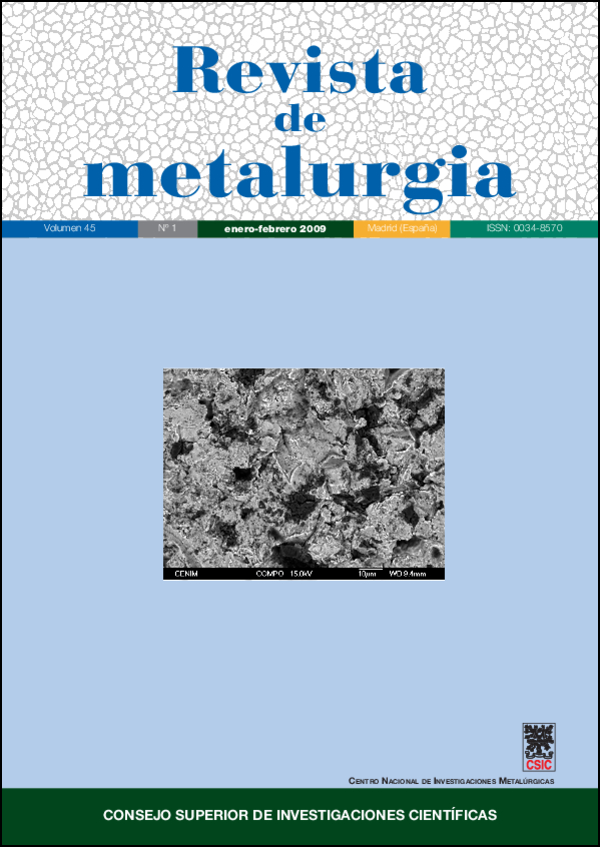Vacuum furnace equipment for quantitative determination of trapped gases in castings
DOI:
https://doi.org/10.3989/revmetalm.0805Keywords:
Porosity, Trapped gas, Vacuum furnace, Die castingAbstract
Parts manufactured with casting processes may trap substantial quantities of gas, which could harm the mechanical properties of the manufactured parts. In this work, a vacuum melting device manufactured to measure trapped gas in castings is described. Adjustment correlations, which accurately calculate trapped gas quantity as a function of the pressure increments measured by the vacuum equipment, are obtained. Finally, as an application of the equipment, we present the results obtained for several parts manufactured using a pressure die casting machine. It is expected that the vacuum melting device will be useful to optimize the operating conditions which reduce the trapped gas in casting processes.
Downloads
References
[1] ISO 10049, Aluminium Alloy Casting-Visual Method for Assessing the Porosity, 1992.
[2] ASTM E155-00, Standard Reference Radiographs for Inspection of Aluminum and Magnesium Castings, ASTM International, 2000.
[3] ASTM E1441-00, Standard Guide for Computed Tomography (CT) Imaging, ASTM, 2005.
[4] S. Palanisamy, R. Nagarajah, y P. Iovenitti, Transactions of the Die Casting in the Heartland, Indianapolis, EE. UU., 2003, Ed. NADCA, paper T03-22.
[5] T.E. Prucha y R. Nath, Proc. SAE World Congress, Detroit EE. UU., 2003, Ed. SAE International, paper 2003-01-0436.
[6] L. Garber y A.B. Draper, Trans. 10th SDCE Int. Die Casting Exposition and Congress, St. Louis, EE. UU., 1979, Ed. NADCA, Paper G-T79- 022.
[7] L. Luis-Martín, T. Rosa y J. Pérez, Rev. Metal. Madrid 15 (1979) 221-234.
[8] J.R. Brevick y P.S. Cheng, Trans. 18th Int. Die Casting Cong. Exp., Indianapolis (USA), 1995, Ed. NADCA, paper T95-045.
[9] K. S. Anastasiou, P. I. Mech. Eng. B-J Eng., 216 (2002) 969-977.
[10] V.D. Tsoukalas, Int. J. Cast. Metal. Res. 15 (2003) 581-588.
[11] R. Zamora, J.J. Hernández-Ortega, F. Faura, J. López y J. Hernández, J. Manuf. Sci. E-T ASME. 130 (2008).
[12] Y.J. Huang, B.H. Hu, I. Pinwill, W. Zhou y D.M.R. Taplin, Mater. Manuf Process. 15 (2000) 97-105. doi:10.1080/10426910008912975
[13] S.T. Mcclain, MS Degree Thesis, Mississippi State University, 1997.
[14] L. Luis y J.I. Robla, Trans. 12th Int. Die Casting Cong. and Exp., Minneapolis, EE. UU., 1983, Ed. NADCA, paper G-T83-052.
[15] J.I. Robla y L. Luis, J. Vac. Sci. Technol. 4 (1987) 2.693-2.695.
[16] L. Luis y J.I. Robla, Trans. 14th Int. Die Casting Congress and Exposition, Toronto (Canada), 1987, Ed. NADCA, paper G-T87-029.
[17] L. Wang, W. Alguine, M. Gershenzon, G. Savage y K. Rogers, Trans. Die Casting in the Heart - land, Indianapolis, EE. UU., 2003, Ed. NADCA, paper T03-048.
[18] R.D. Webb, 1999. Patent Number 55,987,053.
[19] R. Zamora, Tesis doctoral, Escuela Técnica Superior de Ingeniería Industrial, Universidad Politécnica de Cartagena, 2005.
[20] X. Hao, J. Gu, N. Chen, W. Zhang, y X. Zuo, Appl. Therm. Eng. (2007) doi: 10.1016/j.applthermaleng.2007.12.007
[21] Specialty Handbook,1996, Aluminum and Aluminum alloys, ASM International, pp. 199-206.
[22] G. Bar-Meir, J. Eng. Mater-T ASME 117 (1995) 215-219.
[23] R. Zamora, F. Faura, J. López y J. Hérnandez, Int. J. Ad. Manuf. Tech. 33(2007) 266-277. doi:10.1007/s00170-006-0456-z
[24] J. López, J. Hernández, F. Faura y G. Trapaga, J. Fluid. Eng-T ASME, 122(2) (2000) 349-356.
[25] J. López, F. Faura, J. Hernández y P. Gómez, J. Manuf. Sci. E-T ASME 125(3) (2003) 529- 537.
Downloads
Published
How to Cite
Issue
Section
License
Copyright (c) 2009 Consejo Superior de Investigaciones Científicas (CSIC)

This work is licensed under a Creative Commons Attribution 4.0 International License.
© CSIC. Manuscripts published in both the printed and online versions of this Journal are the property of Consejo Superior de Investigaciones Científicas, and quoting this source is a requirement for any partial or full reproduction.All contents of this electronic edition, except where otherwise noted, are distributed under a “Creative Commons Attribution 4.0 International” (CC BY 4.0) License. You may read here the basic information and the legal text of the license. The indication of the CC BY 4.0 License must be expressly stated in this way when necessary.
Self-archiving in repositories, personal webpages or similar, of any version other than the published by the Editor, is not allowed.
















